Windows Adjustments: The Incredible Expanding Hard Drive
Upgrade your hard drive to a larger device without re-installing Windows or any of your applications – we too were shocked when this worked.
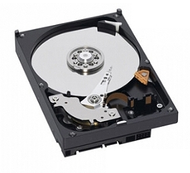 With the benefit of flawless hindsight, some of the computers at the offices of Alchemy Mindworks might have been configured with slightly larger hard drives when they were originally purchased. What seemed like enough storage to encompass the sum of human knowledge with room left over for a modest library of MP3s a few years ago has grown increasingly claustrophobic with time.
With the benefit of flawless hindsight, some of the computers at the offices of Alchemy Mindworks might have been configured with slightly larger hard drives when they were originally purchased. What seemed like enough storage to encompass the sum of human knowledge with room left over for a modest library of MP3s a few years ago has grown increasingly claustrophobic with time.
To render the situation still more nettlesome, really large hard drives are currently available for about as much as a slap-up meal at McDonalds… not that any of us has actually eaten at McDonalds of late. As of this writing, a half-terrabyte drive from Tiger Direct costs about forty dollars.
Swapping hard drives is laughably easy, of course. The daunting part of an increase in digital real estate is reinstalling Windows and several dozen large applications on a new drive. Getting a new system up to speed in these latitudes – including locating the requisite install CDs, downloading patches and recovering registration keys – typically takes several days.
At its most elemental level, a hard drive is just a device to store a profoundly long string of bytes. We routinely exploit this characteristic of digital storage media by cloning the drives in use here, backing them up such that they can be completely restored to their precise state at the time of backup, in the event of alien visitations, sudden eruptions of blue smoke or the onset of cybercretins.
Upon a reasonable undertaking of head scratching, it seemed that the technology used to clone hard drives should make it possible to move everything from a small hard drive onto a large hard drive… without having to reinstall any software. Specifically, the procedure would involve:
- Creating a low-level copy, or “image,” of everything on the old fixed hard drive, and storing it temporarily on a removable USB hard drive.
- Restoring the image to a larger fixed hard drive.
- Adjusting the partition table of the larger hard drive to make all its extra real estate available to Windows.
Working with low-level disk images deceives Windows into thinking it hasn’t moved, and as such, that it doesn’t require that anything be reinstalled or reconfigured. It copies every byte from a source hard drive and places it in precisely the same location on a destination hard drive.
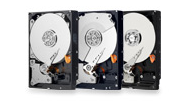 Without wishing to spoil the ending to this tale, I will note that the foregoing procedure works, and it doesn’t entail the application of any differential calculus, quantum mechanics or invocations of unclean spirits. Anyone with a screwdriver and an afternoon to kill can undertake it to relocate an existing Windows installation – or, in fact, the installation of pretty much any installed operating system – to a larger hard drive. If you’re in a spending mood, drives with several terabytes of capacity are available for about a hundred dollars.
Without wishing to spoil the ending to this tale, I will note that the foregoing procedure works, and it doesn’t entail the application of any differential calculus, quantum mechanics or invocations of unclean spirits. Anyone with a screwdriver and an afternoon to kill can undertake it to relocate an existing Windows installation – or, in fact, the installation of pretty much any installed operating system – to a larger hard drive. If you’re in a spending mood, drives with several terabytes of capacity are available for about a hundred dollars.
This said, there are a few details to observe and dragons to fend off – to be dealt with presently.
NOTE: The procedure to be discussed in this posting works with disk images. As such, if the universe is in a truly foul mood at such time as you attempt it, and everything goes horribly wrong, the worst possible outcome will be that you’ll have blown forty dollars on a new hard drive, burned two useless CDRs and ultimately found yourself confronted with replacing your original hard drive in your system and accepting defeat. Unless you actually drop your old hard drive from a considerable height, or your dog makes off with it and buries it, you’re unlikely to trash your computer.
Send in the Clones
The filthy little secrets of hard drive cloning were discussed in detail in the Back Up your Windows Installation posting at this blog. The open-source cloning application discussed therein, Clonezilla, will be required for this adventure as well.
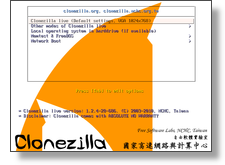 If you haven’t read the foregoing posting, it would be a truly splendid occupation of ten or fifteen minutes to click on the link in the previous paragraph and do so now. You’ll need to download the Clonezilla software and burn it to a CDR before you go any further – the link to do so is at the Clonezilla posting.
If you haven’t read the foregoing posting, it would be a truly splendid occupation of ten or fifteen minutes to click on the link in the previous paragraph and do so now. You’ll need to download the Clonezilla software and burn it to a CDR before you go any further – the link to do so is at the Clonezilla posting.
I hasten to add that while Clonezilla is available at no cost, its author does request a modest contribution if you find it useful. In that its use will save you days worth of re-installing software, chasing product codes and hammering your head against a wall while you weep with despair – followed by a lot of drywall patching to repair the resulting head-shaped dents – you should give serious thought to compensating him for his creation.
In addition to Clonezilla, you’ll need another bit of open-source software, the Gnome Partition Editor, or Gparted. The Gnome Partition Editor can be downloaded as an ISO file and burned to a CDR, just like Clonezilla. You should do so before you get any deeper into this posting, so you’ll have it ready for battle. The author of the Gnome Partition Editor is also worthy of a contribution.
Finally, you’ll need a new and presumably much larger hard drive. You should determine what sort of drive is currently installed in your computer. Unless your system is somewhat unusual or was built by elves, it will have a 3.5 inch SATA drive bolted into it. In theory, any SATA drive can be replaced by any other SATA drive. In the cause of keeping the number chainsaws to be juggled down to a minimum, we made sure to use the same model of hard drive for these upgrades. For example, the machine upon which I’m writing this post began its life with an 80-gigabyte Western Digital Caviar Blue drive. It was upgraded to a 500-gigabyte Western Digital Caviar Blue drive.
Should you be reading this with an eye to increasing the drive space on a laptop, your choice of drive hardware will be substantially different than ours, and you’ll likely need much smaller screwdrivers. Best of luck with this – I hate taking laptops apart.
One of the unusual characteristics of all the computers to which we applied the procedure to be discussed herein was that their hard drives were installed in Vantec EZ_Swap hard drive racks. Unlike conventional hard drive installations, these things store a system’s hard drive in a removable aluminum box that lives in a hitherto unused CD-ROM drive bay. This made exchanging drives a great deal easier, as there was no need to take the computers in question apart to do so.
Sword in Hand
The first adventure in relocating your hard drive involves transferring its disk image to a larger drive. To make this happen:
- Use Clonezilla to back up a disk image of your entire hard drive to a USB drive, as discussed at the aforementioned Clonezilla posting to this blog.
- Remove your old hard drive from your computer.
- Install your new, much larger hard drive in your computer.
- Use Clonezilla to restore the previously backed-up disk image to your new hard drive.
Some slight elaboration on the foregoing is arguably called for.
To begin with, it’s unquestionably worth noting that cloning and restoring hard drive images is grotesquely time consuming. Depending upon the size and speed of your original drive, plan on at least several hours to back up its image, and about half that long to restore it to a new drive.
You needn’t be present while Clonezilla is deep in thought, as all you’ll see on screen will be a lot of meaningless and mildly scary numbers.
If your computer doesn’t include a rack-mounted removable hard drive – necessitating the application of a screwdriver to remove and replace its hard drive – be sure to power it down and unplug it before you start trying to figure out how to case opens. It’s a very good idea to touch something grounded before you turn your attention to its inner workings, to discharge any static electricity that might have attached itself to you. Woolen sweaters and other static-friendly apparel are not fashionable while digging around inside a computer.
With your original disk image restored to your new hard arrive, you should be able to boot up your system normally. If you check the available disk space, you’ll be profoundly disappointed to learn that it’s just as it was before you began disassembling stuff. Shut your system down again and stave off despair.
The final act in the grand opera of hard drive expansion involves adjusting the partitions on your new drive. In some quarters, partition management is regarded as being akin to rebuilding the engine of a Ferrari Testarossa using a can opener and a Leatherman. I hasten to add that we’re not going to get too deeply into the subject here.
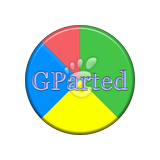 The huge empty space of a hard drive is organized into big chunks of real estate called “partitions.” Partitions are often referred to as “logical drives,” and while the two terms aren’t strictly speaking interchangeable, we’ll regard them as a convenient fiction for the moment.
The huge empty space of a hard drive is organized into big chunks of real estate called “partitions.” Partitions are often referred to as “logical drives,” and while the two terms aren’t strictly speaking interchangeable, we’ll regard them as a convenient fiction for the moment.
The C: drive on your system – the place where all your files live and from whence Windows boots – is one partition. Depending upon who installed Windows on your system, it might well be the only partition, in which case adjusting it will be about as complicated as determining when a liberal politician is lying.
Should it not be immediately apparent, it happens any time their lips are moving.
If your computer presents you with two logical drives – typically drive C: and drive D: – even through you know full well that there’s only one hard drive in there – you have two partitions. This was a common arrangement for hard drives back in the twentieth century, because the operating systems of the day had uncomfortable upper limits on the maximum size of a partition. This is no longer the case, and it’s no longer common to see hard drives configured like this.
An exception to the foregoing observation is multiple-boot drives, allowing a single computer to boot up one of several installed operating systems. If you knew enough to set up your system this way, you probably don’t need this posting to tell you how to manage partitions.
A somewhat more common arrangement of partitions is a single large primary partition – representing your C: drive – with one or more very small “utility” partitions, which can hold Windows replacement operating system files or software tools provided by the company that built your computer. The former are referred to as “Windows rescue partitions,” to be used by Windows if your system refuses to boot. One of the Dell systems we expanded, for example, included a rescue partition and a partition with Dell’s proprietary system tools.
I hasten to add that we’ve never used the contents of either partition.
To see how the partitions on your hard drive are configured, and thence to adjust them, you’ll need to put the Gnome Partition Editor CDR mentioned earlier in this posting in your CD-ROM drive and reboot your computer. Like Clonezilla, the Gnome Partition Editor includes a small implementation of the Linux operating system that will boot up from its parent CD. When it’s done streaming numbers past your monitor and asking you about your keyboard, you’ll have access to the GParted application.
As an aside, I should note that versions of Windows newer than XP come with some partition management tools of their own. They’re probably capable of performing the tasks that the Gnome Partition Editor will be put to here. We haven’t tried using them in this capacity.
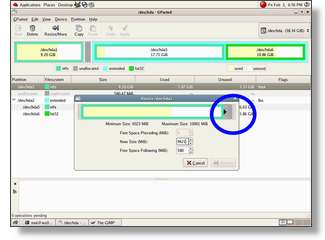 If you have a single NTFS partition, this being your C drive, followed by a great deal of unallocated space, you can expand the drive C partition by clicking on it to select it, selecting Resize / Move from the Partition menu and then dragging the size indicator all the way to the right.
If you have a single NTFS partition, this being your C drive, followed by a great deal of unallocated space, you can expand the drive C partition by clicking on it to select it, selecting Resize / Move from the Partition menu and then dragging the size indicator all the way to the right.
Once you’ve done so, click on Apply in the tool bar and the deed will have been done.
The hard drive space occupied by a partition must be contiguous. As such, if your drive C partition appears with a small rescue partition immediately after it, followed by all the free space represented by your new hard drive, you won’t be able to expand your primary partition to use the extra space as things stand. There are several ways to resolve this:
- Delete the rescue partition. Listen carefully – serious Windows users are probably gasping in horror as you read this. The rescue partition stores files that Windows can use to restore itself if it manages to become corrupted. The catch is that this procedure only works for certain very select forms of operating system catastrophes, and you can arrive at much the same solution with a Windows install CD. This is, in fact, what we did when we were confronted with this problem.
- Move the rescue partition to the end of the free hard drive space. The Gnome Partition Editor claims to be able to move partitions, and it almost certainly can. We never had cause to try it in this regard. There’s a discussion of it at the GParted web page if you’re feeling adventurous.
- Create a new NTFS partition out of your available free space, and use it as, for example, drive D: under Windows. This works, but it seems to defeat the purpose of the exercise. I prefer big, single-partition, poorly-organized hard drives… color me irresponsible.
As was noted earlier, keep in mind that you’re working with a copy of your original hard drive. If you delete, move or reconfigure something that you later wish you hadn’t, such that Windows subsequently refuses to boot or otherwise misbehaves, you can restore the disk image you backed up onto your new hard drive once again, and start over.
If you find that your primary NTFS hard drive partition has one or more small utility partitions before it, resist the urge to delete them to free up their space. Windows’ boot sequence includes a file that tells it which partition to regard as its bootable drive. If, for example, your primary bootable partition is currently the second partition on your hard drive, the first partition being a utility partition, Windows will want to boot to the second partition. Delete the underlying utility partition and your primary bootable partition will become the first partition. Windows will still think it’s supposed to boot from the second partition which will no longer be there, and it will go into vapor lock.
Once you’ve repartitioned your hard drive to your satisfaction, you can exit the Gnome Partition Editor, and restart your system to boot Windows.
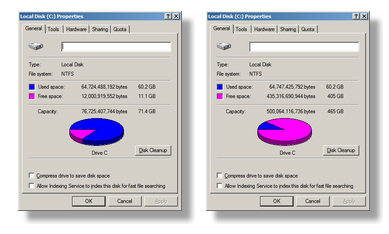 It’s extremely likely that Windows will display a screen to alert you that your file system has become “dirty.” This does not mean that it has been downloading porn behind your back, or that it has failed to wash behind its ears. Windows has detected that the state of your file system has changed unexpectedly since it last booted – a valid observation, this, since its hard drive probably just got about ten times larger.
It’s extremely likely that Windows will display a screen to alert you that your file system has become “dirty.” This does not mean that it has been downloading porn behind your back, or that it has failed to wash behind its ears. Windows has detected that the state of your file system has changed unexpectedly since it last booted – a valid observation, this, since its hard drive probably just got about ten times larger.
Windows will run CHKDSK, which is a gruelingly slow undertaking on a large drive. Don’t attempt to abort this function or reboot your computer, as Windows will just run the beast again the next time it boots. Let CHKDSK complete its scan, and Windows should boot up normally.
You should, of course, run some applications and generally scope out your system once Windows is returned to consciousness. This said, the incredible expanding hard drive is largely bulletproof. It certainly represented the best forty dollars we’d spent in recent memory.
Please see the disclaimers for Windows Adjustments before you apply the information at this post.
Leave a comment
Please note: Support issues can't be addressed here. If you have questions
or if you you need assistance with our software, please visit our support page.
Comments which reference other web pages, or which constitute attempts at
advertising, will be automaticaly flagged as spam and will never see daylight.
Entering a comment at this page will cause one or more cookies to be set in
your web browser.
You must be logged in to post a comment.